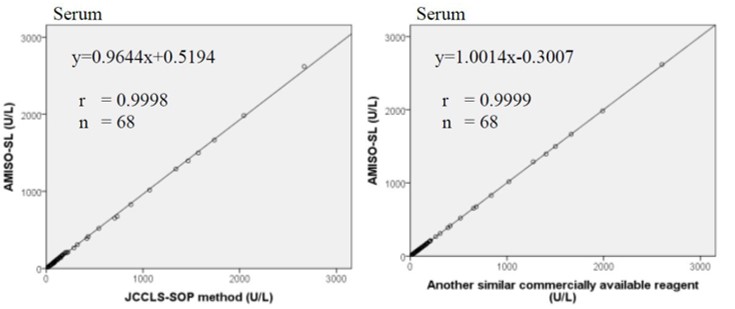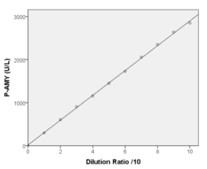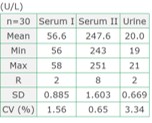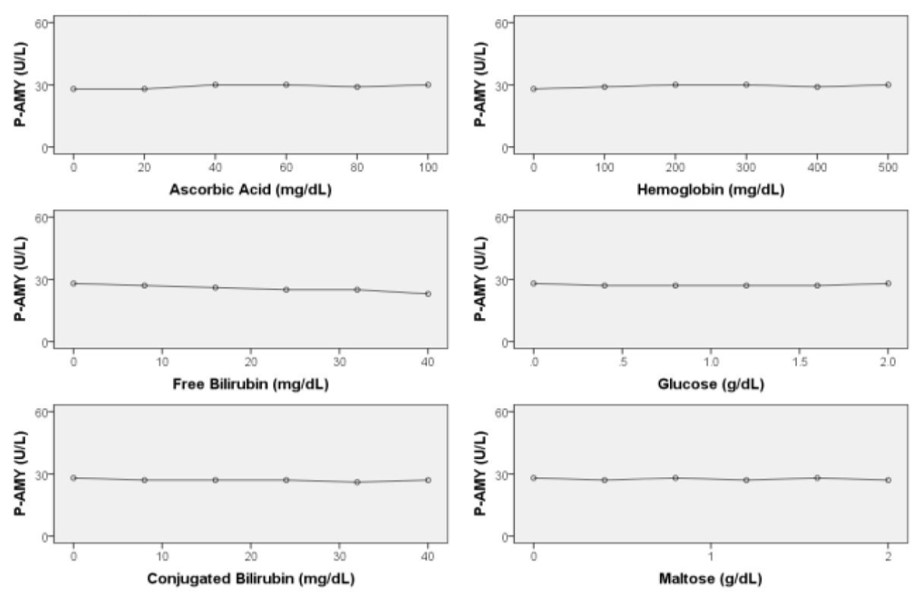
Description
The measurement of α-amylase is useful in the diagnosis and treatment of pancreatitis.
However, the level of α-amylase activity is not specifically an indication of pancreatic disorder, since the enzyme is also produced by the salivary gland and other organs.
Clinical evaluations of patients with acute pancreatitis have shown that pancreatic amylase has a greater sensitivity than total amylase.
High Values:
Causes:
Pancreatic disease, pancreatitis, trauma, tumours etc.
Low Values:
Causes:
Pancreatic cancer (end stage), pancreatectomy
Features
- IFCC transferable method
- High linearity (range 3 – 2000 U/L) and high repeatability
- Little interference by coexisting substances
Intended Use
Our reagents are specifically designed for the in vitro-quantitative determination of pancreas-specific amylase in human serum, plasma and urine.
Principle of the Method
This assay is used to measure pancreatic amylase (P-AMY) by an immuno-inhibition method.
The anti-salivary amylase antibody reacts specifically with the salivary amylase (S-AMY) and inhibits its activity.
Ethylidene-4-NP-G7 (Et-4NP-G7) is hydrolyzed by pancreatic α-amylase to form 4,6-ethylidene-α-(1,4)-D-glucopyranosyl-Gx and 4-nitrophenyl-α-(1,4)-glucopyranosyl-G(7-x). The 4-nitrophenyl-α-(1,4)-glucopyranosyl-G(7-x) is then hydrolyzed into glucose monomers and the 4-nitrophenol by α-glucosidase (α-GH) and glucoamylase (GA). The resulting change in absorbance at 405 nm is proportional to the pancreatic α-amylase concentration in the sample.
The use of the ethylidene prevents exo – enzymes from breaking down the substrate, so in the absence of α-amylase no color change is observed.

Assay Procedure
Individual instrument applications are available on request.

Assay Reagents, Storage and Stability
Reagent 1: Good’s buffer, Anti-Salivary Amylase Antibody (mouse monoclonal antibody), α-Glucosidase, Glucoamylase, Sodium chloride, Calcium acetate, pH 7.0 (25 °C)
Reagent 2: Good’s buffer, Et-4NP-G7, Sodium chloride, Calcium acetate, pH 7.0 (25 °C)
Both reagents are liquid, ready to use
Storage: 2-10 °C
Shelf Life: 12 months (before use)
Stability after Opening: at least 1 months at 2-10 °C
Performance Data
The following performance data were obtained on a Hitachi 7180 clinical analyzer.
Method Comparison
Comparison studies were carried out using another similar commercially available method. The following results were obtained.

JCCLS: Japanese Committee for Clinical Laboratory Standards
Sensitivity
The sensitivity was evaluated by reading the change in absorbance for purified water sample and serum samples with known concentrations. The results indicated that AMY-SL showed little or no reagent drift on a zero sample.
Under the reaction condition described, 321 U/L AMY activity gives a ΔABS/min of 0.011-0.030.
Linearity

Precision (within-run)

Interfering Substances

Request Information
Aziza Aknin
Key Account Manager
